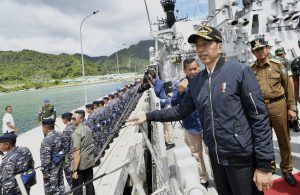China and Indonesia seem to be at it again in the Natuna waters. In late December, dozens of Chinese boats were fishing across at least 30 different location within Indonesia’s exclusive economic zone (EEZ) accompanied by several coast guard vessels. Indonesia summoned the Chinese ambassador to Jakarta and issued a strong diplomatic protest.
During several weeks of the ensuing stand-off, the Indonesian military deployed warships and fighter jets into the area as both sides traded barbs through the press. Indonesian President Joko “Jokowi” Widodo also visited Natuna and boarded one of the navy’s warships in the area. By mid-January, the Chinese vessels had largely cleared the Natuna EEZ (dubbed the North Natuna Sea in 2017).
The incident left a bitter aftertaste in Jakarta. Why did Beijing squander its strategic capital in Jakarta over what law enforcement officials consider to be “low value fisheries”? Did Indonesia really stare down the Chinese? Will a maritime crisis in the Natunas happen again?
Natuna: What’s the Problem?
Indonesia is a “nonclaimant” in the South China Sea as it does not stake a legal claim in any of the disputed parts of the area; it also does not recognize China’s illegal claim over parts of the Natuna EEZ.
Analysts like to note that Indonesia and China have a dispute around the Natuna EEZ. But a dispute implies both sides equally have some rights under the law to begin with. The problem is that Indonesia’s rights are recognized by international law, particularly the 1982 United Nations Convention on the Law of the Sea (UNCLOS), and China’s are not.
UNCLOS acknowledges that Indonesia only has overlapping claims with Malaysia and Vietnam in the area.
China’s claim over the fishery resources within the Natuna EEZ is not backed by UNCLOS. A 2016 ruling by the International Tribunal on the Law of the Sea (through the Permanent Court of Arbitration) further declared China’s nine-dash line claim over the whole of the South China Sea to be illegal. So, if there is a dispute — i.e. genuine EEZ overlap — between Indonesia and China, where exactly are the coordinates for China’s claim and their international legal basis?
Put more simply: One side has a valid and legal claim and the other conjures up legal figments at the expense of international law. No amount of fabricated legal-sounding phrases — “historic fishing ground” or “jurisdiction over relevant waters” — will change this reality.

































